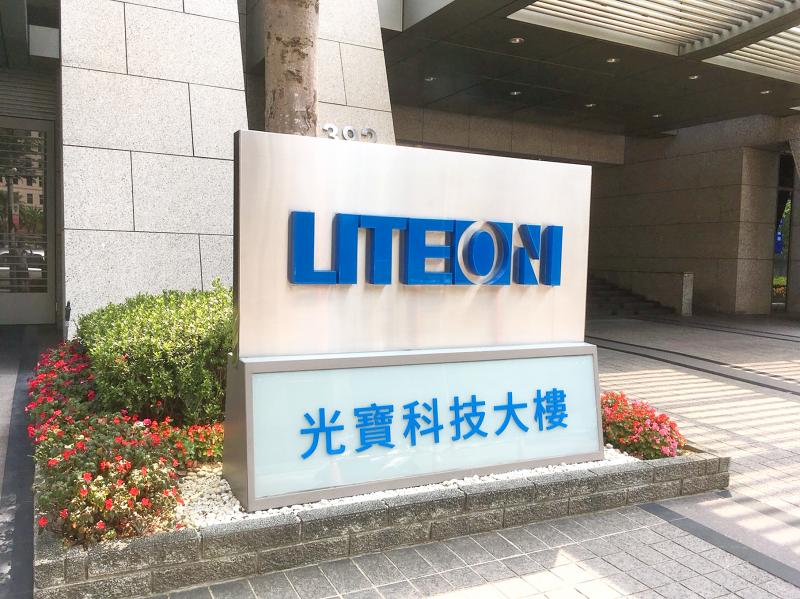Lite-On Technology Corp (光寶科技) yesterday reported its highest earnings per share (EPS) in five years for the October-to-December quarter, thanks to an improved product mix and operating efficiency, the electronic components supplier said in a statement.
The company posted fourth-quarter net profit of NT$2.51 billion (US$90.05 million), up 25 percent from a year earlier, but down 19 percent from the previous quarter on revenue of NT$44.57 billion. It was also up 8 percent year-on-year and 6 percent quarter-on-quarter.
Lite-On attributed the annual increases to steady growth in demand for products used in optoelectronics, cloud computing, 5G, artificial intelligence of things (AIoT) and automotive applications.

Photo: Chen Rou-chen, Taipei Times
EPS reached NT$1.11 in the quarter, the highest for the October-to-December period over the past five years, as gross margin and operating margin improved to 17.3 and 8.1 percent respectively, up from 16.2 and 4.4 percent a year earlier.
That brought last year’s total net profit to NT$13.89 billion, up 39 percent from 2020, with EPS rising from NT$4.31 to NT$6.01, a record, Lite-On said.
Gross margin increased 1.1 percentage points annually to 18.5 percent, while operating margin rose 1.4 percentage points to 7.9 percent, it said.
“Due to continually optimizing our product mix, improving our flexibility and response times through smart manufacturing and supply-chain management, and boosting our operational efficiency, 2021 resulted in a record profit margin and EPS,” the statement said.
Lite-On reported revenue of NT$164.83 billion for the whole of last year, up 5 percent from a year earlier.
The increase is as high as 10 percent if a business transfer in 2020 is excluded, said the company, which sold its solid-state drive business to Japan’s Kioxia Holdings Corp on July 1, 2020.
Last year, Lite-On’s optoelectronics segment contributed 20 percent of its total revenue, while the cloud computing and AIoT segment contributed 27 percent, and the information technology and consumer electronics segment contributed 53 percent.
The company continues to implement a market-oriented strategy, and expanded research and development by more than 20 percent last year, especially in optoelectronics, cloud computing, automotive electronics, and 5G and AIoT products, Lite-On president Anson Chiu (邱森彬) said.
Although its business model has shifted from original equipment manufacturing and original design manufacturing, the company aims to offer customers a systematic solution through in-house product development, Chiu said.
“Automotive electronics and 5G/AIOT products continued to obtain customer certifications in the past two years,” Chiu said in the statement. “As market momentum continues to grow, they will become the growth drivers for Lite-On.”
The company also aims to expand into smart grid solutions for household energy management in the medium to long term, creating a new growth driver, it said.

Shares in Taiwan closed at a new high yesterday, the first trading day of the new year, as contract chipmaker Taiwan Semiconductor Manufacturing Co (TSMC, 台積電) continued to break records amid an artificial intelligence (AI) boom, dealers said. The TAIEX closed up 386.21 points, or 1.33 percent, at 29,349.81, with turnover totaling NT$648.844 billion (US$20.65 billion). “Judging from a stronger Taiwan dollar against the US dollar, I think foreign institutional investors returned from the holidays and brought funds into the local market,” Concord Securities Co (康和證券) analyst Kerry Huang (黃志祺) said. “Foreign investors just rebuilt their positions with TSMC as their top target,

H200 CHIPS: A source said that Nvidia has asked the Taiwanese company to begin production of additional chips and work is expected to start in the second quarter Nvidia Corp is scrambling to meet demand for its H200 artificial intelligence (AI) chips from Chinese technology companies and has approached contract manufacturer Taiwan Semiconductor Manufacturing Co (TSMC, 台積電) to ramp up production, sources said. Chinese technology companies have placed orders for more than 2 million H200 chips for this year, while Nvidia holds just 700,000 units in stock, two of the people said. The exact additional volume Nvidia intends to order from TSMC remains unclear, they said. A third source said that Nvidia has asked TSMC to begin production of the additional chips and work is expected to start in the second

REVENUE PERFORMANCE: Cloud and network products, and electronic components saw strong increases, while smart consumer electronics and computing products fell Hon Hai Precision Industry Co (鴻海精密) yesterday posted 26.51 percent quarterly growth in revenue for last quarter to NT$2.6 trillion (US$82.44 billion), the strongest on record for the period and above expectations, but the company forecast a slight revenue dip this quarter due to seasonal factors. On an annual basis, revenue last quarter grew 22.07 percent, the company said. Analysts on average estimated about NT$2.4 trillion increase. Hon Hai, which assembles servers for Nvidia Corp and iPhones for Apple Inc, is expanding its capacity in the US, adding artificial intelligence (AI) server production in Wisconsin and Texas, where it operates established campuses. This

US President Donald Trump on Friday blocked US photonics firm HieFo Corp’s US$3 million acquisition of assets in New Jersey-based aerospace and defense specialist Emcore Corp, citing national security and China-related concerns. In an order released by the White House, Trump said HieFo was “controlled by a citizen of the People’s Republic of China” and that its 2024 acquisition of Emcore’s businesses led the US president to believe that it might “take action that threatens to impair the national security of the United States.” The order did not name the person or detail Trump’s concerns. “The Transaction is hereby prohibited,”